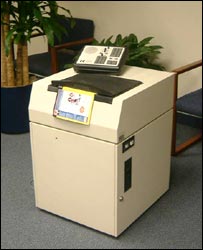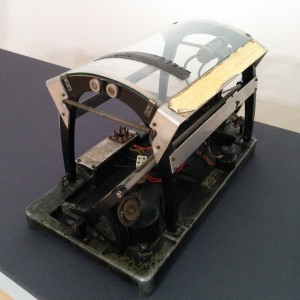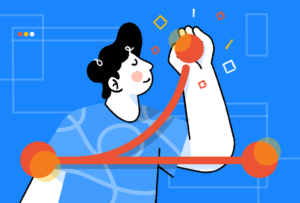I love looking at early technology and seeing how people problem-solve

Originally published in the SitePoint Design Newsletter.
Back in the early 80’s, I remember our sixth-grade teacher taking us to see a ‘new wonder device’ – a Kurzweil reading machine.
It wasn’t exactly a sexy design. It looked like a photocopier but was closer to the size of a family washing machine. You placed an open book on the top and it read aloud, even turning pages when required. The voice synthesizer was a little harsh on the ear but, hey, it was 1981 and this thing spoke better english than R2-D2, so it was hard to be super-critical.
We all thought it was very cool – but also wet-your-pants hilarious when the machine attempted to ‘read’ illustrations as text. “Period,… tee, …. owe, owe, period…. hyphen, … hyphen, owe.., jay, owe“.
It was funny. Trust me.
These machines were a really big deal at the time. Walter Cronkite once used one to sign off from his national TV news show and Stevie Wonder adored his. It’s easy to forget that reading privacy is an everyday luxury that visually-challenged users lose. This invention gave that back.
So, Was This the First Reading Machine?
Not quite.

This is the Optophone, a reading machine that was invented just before the First World War – in 1913.
How is that even possible, right?
This is before television, transistors, vacuum tubes – planes still look like jumped-up kites. It’s hard to even contemplate tackling this challenge at a time when electricity in the home was still a novelty.
But someone did. His name was Edmund Edward Fournier d’Albe and he was an Irish physicist, inventor, and all-round renaissance guy.
How did the Optophone work?

Like Kurzweil’s machine, readers placed the book on the glass top and the reading head below rocked from side-to-side, playing audio to the user through a headset.
Fournier d’Albe’s invention relied on using selenium cells to turn reflected light from the page into different musical tones.
Users would learn to associate particular sounds with letters, and construct words and sentences that way.
It certainly wasn’t a perfect system. Even the most skilled blind users only achieved reading speeds of around 60 words per minute. Most sighted readers hum along at closer to 300. Still, it sure beats zero.
But perhaps the biggest hurdle for users was the so-called ‘music’ it produced. Unfortunately, the tones it made were teeth-jarringly awful.
Don’t believe me? We can still listen to them today on this SoundCloud recording.
The Optophone was in use into the 1920’s but steadily fell out of favor by the 1930’s. Hearing those blaring tones, that’s not a huge surprise. It would be hard to appreciate even beautiful words rendered in those flat squawks.
To me, the curious thing is, in 1913 the high-point of technology was still probably high-precision timepieces. Clockmakers had been building incredibly intricate devices with stunningly beautiful chimes for hundreds of years. I wonder if Fournier d’Albe’s had been able to partner with a good clockmaker – words turned into delicate melodies rather than electrical discharge – the Optophone might have given a longer, fuller working life?
For all it’s problems, it took until well into the 1970’s for us to make something better.
Originally published in the SitePoint Design Newsletter.
Frequently Asked Questions (FAQs) about Machine Readers
What are machine readers and how do they work?
Machine readers, also known as reading machines, are assistive technology devices designed to convert printed text into spoken words. They use Optical Character Recognition (OCR) technology to scan and recognize text from a printed page, and then a text-to-speech engine to read the text aloud. This technology is particularly beneficial for individuals with visual impairments or reading disabilities, as it allows them to access printed materials independently.
How can machine readers benefit individuals with visual impairments?
Machine readers can significantly enhance the independence and quality of life for individuals with visual impairments. They provide access to printed materials such as books, newspapers, and personal documents, which may otherwise be inaccessible. This can greatly improve educational and employment opportunities, as well as everyday tasks like reading mail or following a recipe.
Are there different types of machine readers available?
Yes, there are various types of machine readers available, each with different features and capabilities. Some are standalone devices, while others are software programs that can be installed on a computer or mobile device. Some machine readers also include features like magnification, color contrast settings, and the ability to save and retrieve documents.
How accurate are machine readers in recognizing and reading text?
The accuracy of machine readers can vary depending on several factors, including the quality of the printed material and the specific technology used by the device. However, most modern machine readers are quite accurate and can effectively recognize and read a wide range of printed materials.
Can machine readers read handwriting?
While some advanced machine readers may have the capability to recognize and read certain types of handwriting, this is generally more challenging than reading printed text. The legibility and style of the handwriting can significantly impact the accuracy of the recognition.
Are machine readers easy to use?
Most machine readers are designed to be user-friendly, with simple controls and intuitive interfaces. However, there may be a learning curve when first starting to use the device, and some individuals may require training or assistance.
Can machine readers be used with other languages?
Many machine readers are multilingual and can recognize and read text in multiple languages. However, the specific languages supported can vary between different devices.
Are machine readers portable?
Some machine readers are portable and can be easily carried in a bag or backpack, while others are larger and more stationary. There are also mobile apps that can turn a smartphone or tablet into a portable machine reader.
How much do machine readers cost?
The cost of machine readers can vary widely depending on the specific device and its features. Some basic models may be relatively affordable, while more advanced devices with additional features can be more expensive.
Where can I purchase a machine reader?
Machine readers can be purchased from a variety of sources, including specialized assistive technology retailers, online marketplaces, and sometimes directly from the manufacturer. It’s important to research and compare different options to find the device that best meets your needs and budget.
 Alex Walker
Alex WalkerAlex has been doing cruel and unusual things to CSS since 2001. He is the lead front-end design and dev for SitePoint and one-time SitePoint's Design and UX editor with over 150+ newsletter written. Co-author of The Principles of Beautiful Web Design. Now Alex is involved in the planning, development, production, and marketing of a huge range of printed and online products and references. He has designed over 60+ of SitePoint's book covers.





